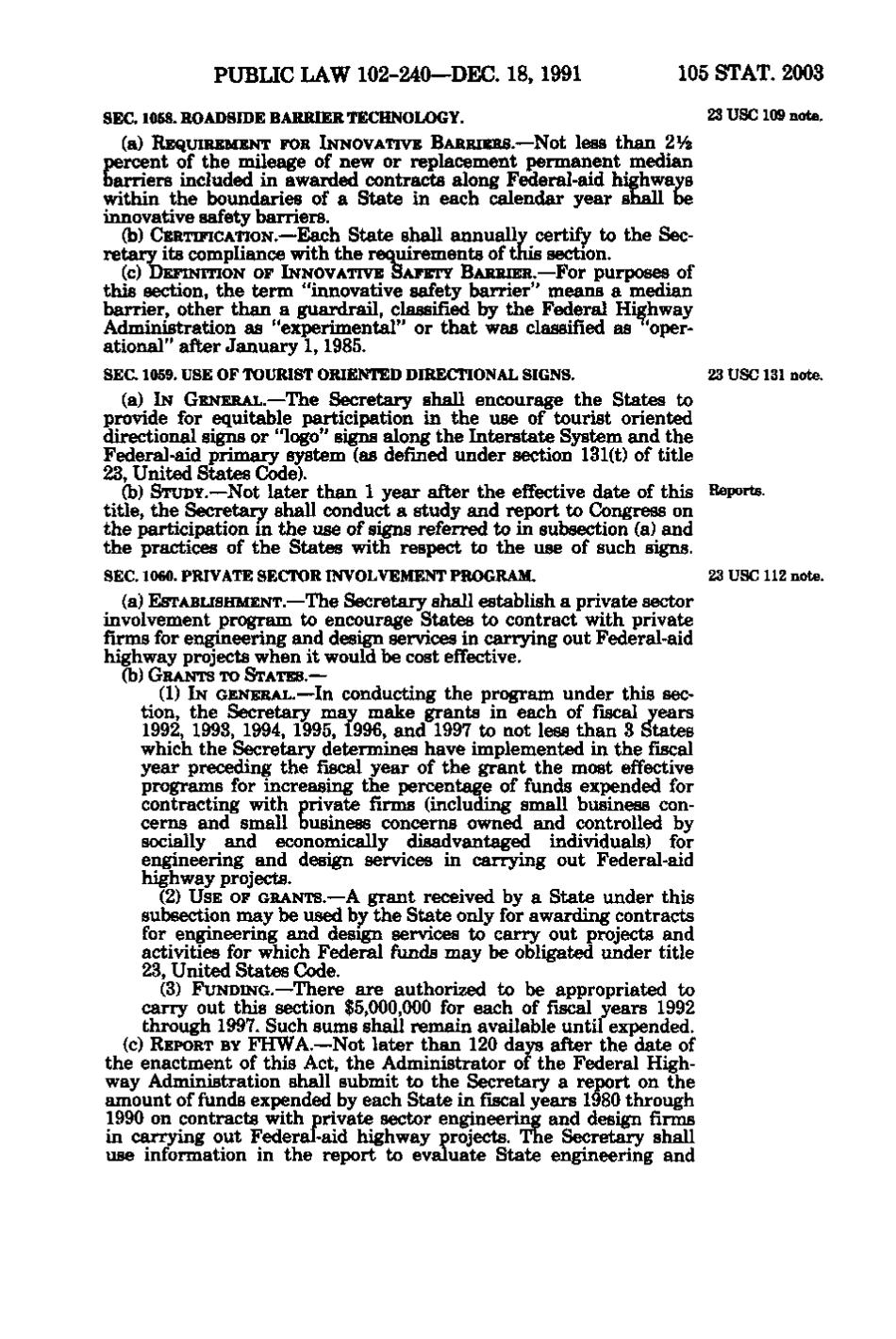PUBLIC LAW 102-240—DEC. 18, 1991 105 STAT. 2003 SEC. 1058. ROADSIDE BARRIER TECHNOLOGY. 23 USC 109 note. (a) REQUIREMENT FOR INNOVATIVE BARRIERS. —Not less than 2V2 percent of the mileage of new or replacement permanent median barriers included in awarded contracts along Federal-aid highways within the boundaries of a State in each calendar year shall be innovative safety barriers. (b) CERTIFICATION.— Each State shall annually certify to the Secretary its compliance with the requirements of tnis section, (c) DEFINITION OF INNOVATIVE SAFETY BARRIER.—For purposes of this section, the term "innovative safety barrier" means a median barrier, other than a guardrail, classified by the Federal Highway Administration as "experimental" or that was classified as "operational" after January 1, 1985. SEC. 1059. USE OF TOURIST ORIENTED DIRECTIONAL SIGNS. 23 USC 131 note. (a) IN GENERAL. —The Secretary shall encourage the States to provide for equitable participation in the use of tourist oriented directional signs or "logo" signs along the Interstate System and the Federal-aid primary system (as defined under section 131(t) of title 23, United States Code). (b) STUDY.— Not later than 1 year after the effective date of this Reports, title, the Secretary shall conduct a study and report to Congress on the participation in the use of signs referred to in subsection (a) and the practices of the States with respect to the use of such signs. SEC. 1060. PRIVATE SECTOR INVOLVEMENT PROGRAM. 23 USC 112 note. (a) ESTABLISHMENT. — The Secretary shall establish a private sector involvement program to encourage States to contract with private firms for engineering and design services in carrying out Federal-aid highway projects when it would be cost effective. (b) GRANTS TO STATES. — (1) IN GENERAL.— In conducting the program under this section, the Secretary may make grants in each of fiscal years 1992, 1993, 1994, 1995, 1996, and 1997 to not less than 3 States which the Secretary determines have implemented in the fiscal year preceding the fiscal year of the grant the most effective programs for increasing the percentage of funds expended for contracting with private firms (including small business concerns and small business concerns owned and controlled by socially and economically disadvantaged individuals) for engineering and design services in carrying out Federal-aid highway projects. (2) USE OF GRANTS.— A grant received by a State under this subsection may be used by the State only for awarding contracts for engineering and design services to carry out projects and activities for which Federal funds may be obligated under title 23, United States Code. (3) FUNDING. —There are authorized to be appropriated to carry out this section $5,000,000 for each of fiscal years 1992 through 1997. Such sums shall remain available until expended. (c) REPORT BY FHWA. —Not later than 120 days after the date of the enactment of this Act, the Administrator of the Federal Highway Administration shall submit to the Secretary a report on the amount of funds expended by each State in fiscal years 1980 through 1990 on contracts with private sector engineering and design firms in carrying out Federal-aid highway projects. The Secretary shall use information in the report to evaluate State engineering and
�
